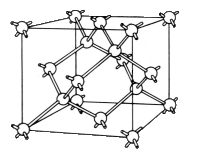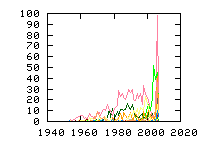« Previous
1
Next »
(16 hits, 1/1)
Showing
10, 25, 50, 100, 500, 1000, all papers per page.
Sort by:
last publication date,
older publication date,
last update date.
- 1. Phys. Rev. Lett. 98, 055504 (2007) , “Ortho-Para Conversion of Interstitial H2 in Si”, M. Hiller, E. V. Lavrov, and J. WeberOrtho-para conversion of isolated interstitial H2 in single-crystalline Si is studied by Raman scattering. This process is suggested to be caused by the interaction of H2 with the nuclear magnetic moment of 29Si. At 77 K the ortho-to-para conversion rate is... (Read more)
- 2. Appl. Phys. Lett. 89, 211914 (2006) , “Molecular hydrogen formation in hydrogenated silicon nitride”, H. F. W. Dekkers, G. Beaucarne, M. Hiller, H. Charifi, and A. SlaouiHydrogen is released from hydrogenated silicon nitride (SiNx:H) during thermal treatments. The formation of molecular hydrogen (H2) in SiNx:H layers with low mass density is confirmed by Raman spectroscopy. However, no H2 is observed in... (Read more)
- 3. Phys. Rev. B 74, 245203 (2006) , “Diffusion and conversion dynamics for neutral muonium in aluminum nitride”, H. N. Bani-Salameh, R. L. Lichti, Y. G. Celebi, and S. F. J. CoxMuon spin depolarization rates and hyperfine decoupling curves imply the existence of a neutral muonium center to high temperatures in AlN, providing an experimental model for interstitial atomic hydrogen. This center has a hyperfine interaction close to that of the free atom, but with a small... (Read more)
- 4. Phys. Rev. B 74, 235214 (2006) , “Raman scattering study of H2 in Si”, M. Hiller, E. V. Lavrov, and J. WeberIsolated interstitial H2 and H2 bound to interstitial oxygen (O–H2) in single-crystalline Si are studied by Raman scattering. Two Raman signals at 3199(1) and 3193(1) cm−1 (T0 K) are identified as ro-vibrational transitions of... (Read more)
- 5. Phys. Rev. Lett. 97, 155901 (2006) , “Proton Diffusion Mechanism in Amorphous SiO2”, Julien Godet and Alfredo PasquarelloWe study proton diffusion in amorphous SiO2 from the atomic scale to the long-range percolative regime. Ab initio molecular dynamics suggest that the dominant atomic process consists in cross-ring interoxygen hopping assisted by network vibrations. A statistical analysis accounting... (Read more)
- 6. Appl. Phys. Lett. 81, 1839 (2002) , “Dual behavior of H+ at Si–SiO2 interfaces: Mobility versus trapping”, S. N. Rashkeev, D. M. Fleetwood, R. D. Schrimpf, S. T. PantelidesWe report first-principles calculations showing that protons in the vicinity of a Si–SiO2 interface can behave in two different ways. At an abrupt interface without suboxide bonds (Si–Si bonds at the oxide side of the interface) H+ does not become trapped but migrates... (Read more)
- 7. Phys. Rev. Lett. 89, 135507 (2002) , “Diffusion and Reactions of Hydrogen in F2-Laser-Irradiated SiO2 Glass”, Koichi Kajihara, Linards Skuja, Masahiro Hirano, and Hideo HosonoThe diffusion and reactions of hydrogenous species generated by single-pulsed F2 laser photolysis of SiO-H bond in SiO2 glass were studied in situ between 10 and 330 K. Experimental evidence indicates that atomic hydrogen (H0) becomes mobile even at temperatures as... (Read more)
- 8. Phys. Rev. Lett. 87, 165506 (2001) , “Defect Generation by Hydrogen at the Si-SiO2 Interfaces”, S. N. Rashkeev, D. M. Fleetwood, R. D. Schrimpf, and S. T. PantelidesHydrogen is known to passivate Si dangling bonds at the Si-SiO 2 interface, but the subsequent arrival of H + at the interface causes depassivation of Si-H bonds. Here we report first-principles density functional calculations, showing that, contrary to conventional... (Read more)
- 9. Mater. Sci. Eng. B 58, 171-178 (1999) , “Self-Interstitial Related Reactions in Silicon Irradiated by Light Ions”, B. N. Mukashev, Kh. A. Abdullin, Yu. V. Gorelkinskii and S. Zh. TokmoldinRecent deep level transient spectroscopy (DLTS), electron paramagnetic resonance (EPR) and infrared (IR) spectroscopy data on interactions of self-interstitial with carbon, aluminium, oxygen and hydrogen in silicon irradiated by light ions are reviewed. Self-interstitial behaviour in silicon was... (Read more)
- 10. Phys. Rev. Lett. 83, 372 (1999) , “Hydrogen Electrochemistry and Stress-Induced Leakage Current in Silica”, Peter E. Bl?chl and James H. StathisHydrogen-related defects in oxygen-deficient silica, representing the material of a thermal gate oxide, are analyzed using first-principles calculations. Energetics and charge-state levels of oxygen vacancies, hydrogen, and their complexes in the silica framework are mapped out. The neutral hydrogen... (Read more)
- 11. Phys. Rev. Lett. 73, 3419 (1994) , “Non-Arrhenius Reorientation Kinetics for the B-H Complex in Si: Evidence for Thermally Assisted Tunneling”, Y. Michael Cheng and Michael StavolaThe B-H complex in Si can be aligned by stress and reorients with an activation energy of roughly 0.2 eV. We combine new measurements of the reorientation kinetics of the B-H complex made by the stress-induced dichroism technique with previous internal friction results to show that the reorientation... (Read more)
- 12. Phys. Rev. B 47, 3620-3625 (1993) , “{H,B}, {H,C}, and {H,Si} pairs in silicon and germanium”, Dj. M. Maric, P. F. Meier, S. K. EstreicherThe interactions between interstitial H and substitutional B, C, and Si in crystalline silicon and germanium are studied in molecular clusters at the ab initio Hartree-Fock level with large basis sets. The energetics, electronic structures, and relative stabilities of these pairs are determined. Our... (Read more)
- 13. Phys. Rev. B 44, 11486-11489 (1991) , “Reorientation of the B-H complex in silicon by anelastic relaxation experiments”, G. Cannelli, R. Cantelli, M. Capizzi, C. Coluzza, F. Cordero, A. Frova, A. Lo PrestiThe elastic energy loss between 60 and 300 K was measured in SiBxHy at frequencies between 2.4 and 32 kHz. A single-time relaxation process appears in the neighborhood of 130 K, which is due to the stress-induced jumps of H around B, with a relaxation time... (Read more)
- 14. Physica B 170, 155-167 (1991) , “Electron paramagnetic resonance of hydrogen in silicon ”, Yu.V. Gorelkinskii, N.N. Nevinnyi
- 15. Phys. Rev. B 39, 10791-10808 (1989) , “Theory of hydrogen diffusion and reactions in crystalline silicon”, Chris G. Van de Walle, P. J. H. Denteneer, Y. Bar-Yam, and S. T. PantelidesThe behavior of hydrogen in crystalline silicon is examined with state-of-the-art theoretical techniques, based on the pseudopotential-density-functional method in a supercell geometry. Stable sites, migration paths, and barriers for different charge states are explored and displayed in total-energy... (Read more)
- 16. Phys. Rev. Lett. 61, 2786 (1988) , “Hydrogen Motion in Defect Complexes: Reorientation Kinetics of the B-H Complex in Silicon”, Michael Stavola, K. Bergman, S. J. Pearton, and J. LopataThe motion of hydrogen in the B-H complex in silicon has been studied. An applied stress is used to produce a preferential alignment of the B-H complex at temperatures sufficiently high for the H to move within the complex (above ∼60 K). This alignment of the complexes is detected by comparing the... (Read more)
« Previous
1
Next »
(16 hits, 1/1)
Showing
10, 25, 50, 100, 500, 1000, all papers per page.
Sort by:
last publication date,
older publication date,
last update date.
All papers (3399)
Updated at 2010-07-20 16:50:39
Updated at 2010-07-20 16:50:39
(view as: tree
,
cloud
)
| 1329 | untagged |
Materials
(111 tags)
Others(101 tags)
Technique
(46 tags)
Details
(591 tags)
Bond(35 tags)
Defect(interstitial)(18 tags)
Defect(vacancy)(15 tags)
Defect-type(19 tags)
Element(65 tags)
Energy(8 tags)
Isotope(56 tags)
Label(303 tags)
Sample(17 tags)
Spin(8 tags)
Symmetry(15 tags)

